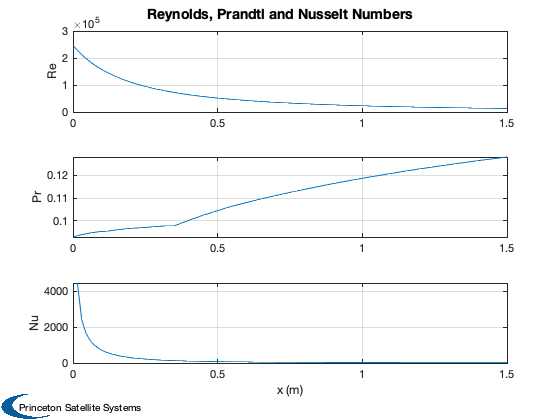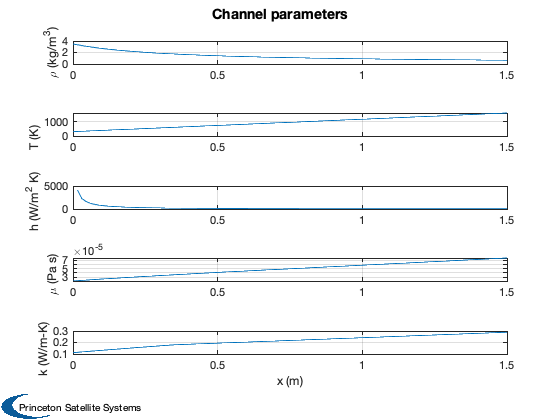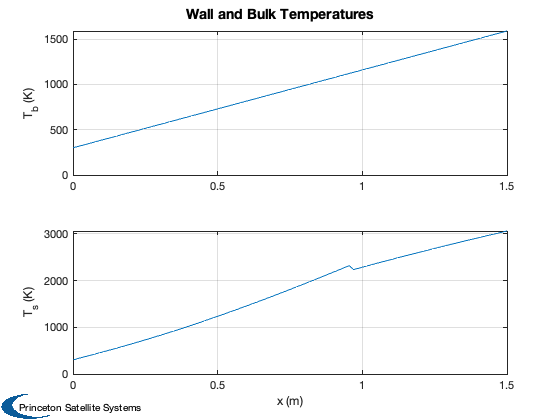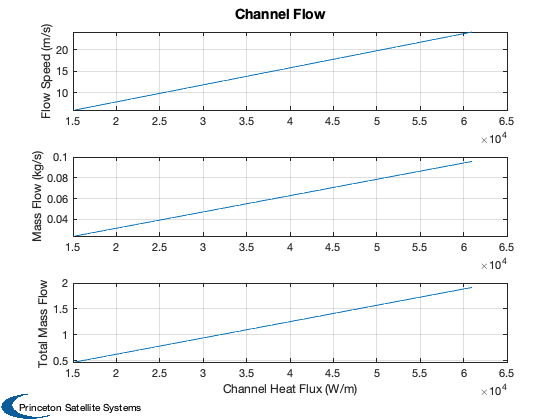Contents
Size the channels for heat transfer with He/Xe
Create a set of circumferential channels around the fusion region. Compute the flow rate to achieve the desired temperatures.
%-------------------------------------------------------------------------- % See also: HeatTransferChannel %-------------------------------------------------------------------------- %-------------------------------------------------------------------------- % Copyright (c) 2017 Princeton Satellite Systems, Inc. % All rights reserved. %--------------------------------------------------------------------------
Inputs
Waste heat, for a 1.1 MW fusion reactor
Q = 0.61e6; % W l = 1.5; % length of radiating plasma, m r = 0.35; % radius of inner wall, m nChannels = 20; % how many ducts tIn = 300; % inlet (cold) temperature tOut = 1589; % out temperature, GE ceramic blades pR = 2; % inlet pressure, ATM gas = {'xe', 0.3, 'he', 0.7}; cP = 494; % 70/30 He/Xe, specific heat/pressure cV = 300; % 70/30 He/Xe, specific heat/volume
Calculate heat per channel
This assumes the flux is uniform around the channel perimeter.
c = 2*pi*r; % circumference w = c/nChannels; % channel width h = 0.5*w; % channel height q = Q/nChannels; % wall loading, W/m, per channel d = struct( 'name', 'Helium/Xenon 70/30',... 'length', l,... % m 'w', w,... % m 'h', h,... % m 'q', q,... % MW 'cP', cP,... % J/kg-K 'gamma', cP/cV,... % ratio 'kC', 0,... % 'kE', 0,... % 'tInlet', tIn,... % K 'tOutlet', tOut,... % K 'tube', 'square',... 'pressure', pR ); % ATM d.gas = gas; [out, ltx] = HeatTransferChannel( d, true ); k = size(ltx,1)+1; ltx{k,1} = 'Total $\dot{m}$'; ltx{k,2} = sprintf('%12.2e',nChannels*out.mDot); ltx{k,3} = 'kg/s'; fprintf(1,'\n\n'); DisplayLatexTable(ltx);
Gas Helium/Xenon 70/30
height 5.50 cm
width 11.00 cm
Q 45750.00 W
$C_p$ 494.00 J/kg-K
$\gamma$ 1.65
$T_i$ 300.00 K
$T_o$ 1589.00 K
$\dot{m}$ 0.047898 kg/s
$\rho_o$ 3.48 kg/m$^3$
$\rho_i$ 0.66 kg/m$^3$
$a_c$ 60.45 cm$^2$
$u$ 12.05 m/s
q 30500.00 W
$\Delta P$ -2.45e-04 Atm
Tube square
Gas Helium/Xenon 70/30
height 5.50 cm
width 11.00 cm
Q 45750.00 W
$C_p$ 494.00 J/kg-K
$\gamma$ 1.65
$T_i$ 300.00 K
$T_o$ 1589.00 K
$\dot{m}$ 0.047898 kg/s
$\rho_o$ 3.48 kg/m$^3$
$\rho_i$ 0.66 kg/m$^3$
$a_c$ 60.45 cm$^2$
$u$ 12.05 m/s
q 30500.00 W
$\Delta P$ -2.45e-04 Atm
Tube square
Total $\dot{m}$ 9.58e-01 kg/s



Flow rate and pressure as a function of heat
Keep the channel size the same, how does the flow vary?
qs = linspace(0.5*q,2*q); for k = 1:length(qs) d.q = qs(k); out = HeatTransferChannel( d ); us(k) = out.u; mDots(k) = out.mDot; end Plot2D(qs,[us;mDots;nChannels*mDots],'Channel Heat Flux (W/m)',... {'Flow Speed (m/s)','Mass Flow (kg/s)','Total Mass Flow'},'Channel Flow') %--------------------------------------
